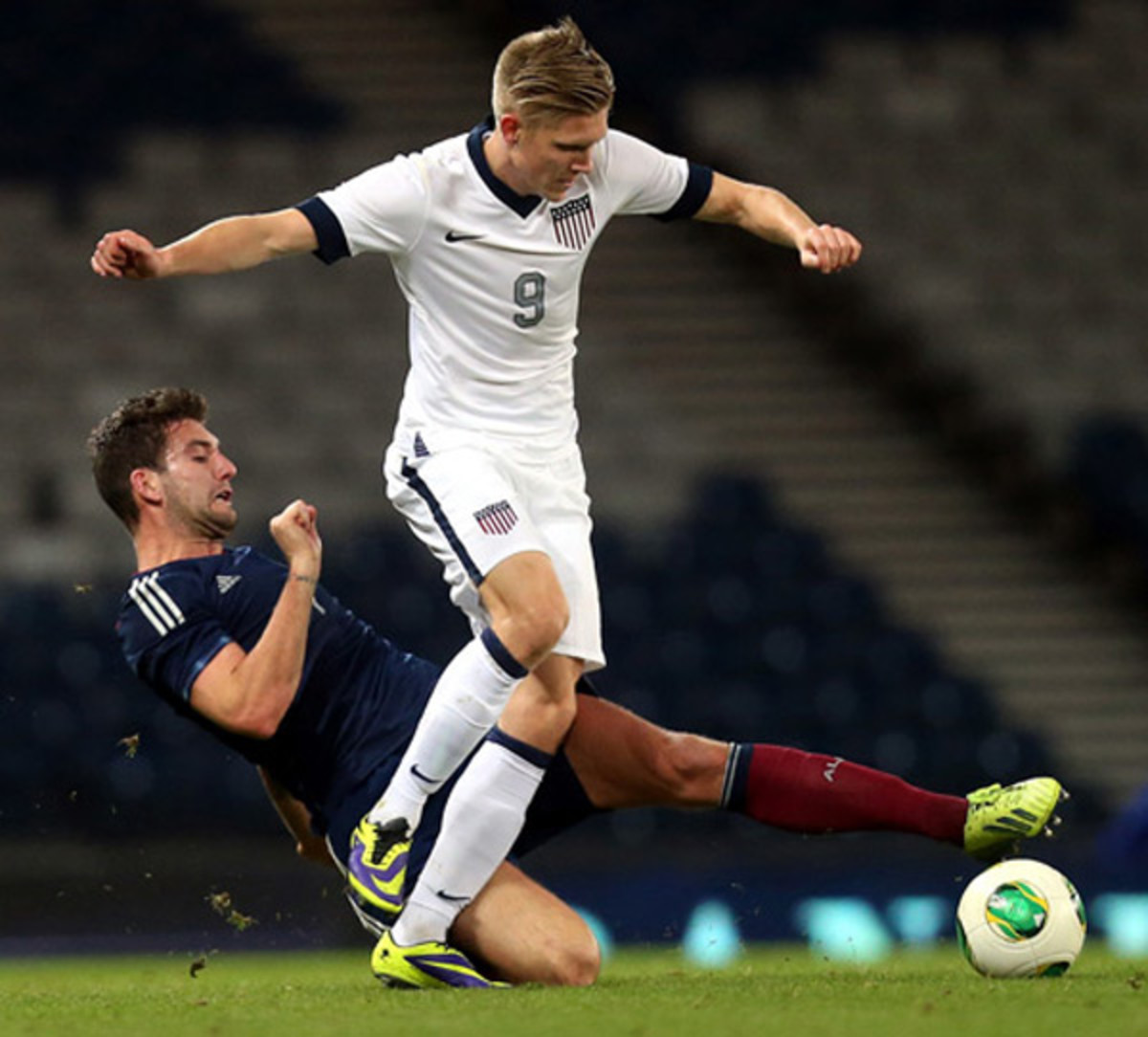
Sluggish in Scotland: Three thoughts on the USA's 0-0 friendly draw
Aron Johannsson (9) provided a spark off the bench for the United States, but he couldn't provide a goal in Friday's 0-0 draw with Scotland. (Scott Heppell/AP)
There were a few decent scoring chances, two hand balls that went unsanctioned by the referee and, well, that was about it during Friday's dreary 0-0 tie between the U.S. and Scotland in Glasgow.
Missing several key contributors and playing without the urgency that's come to define the program under coach Jurgen Klinsmann, the U.S. opened with one of its worst halves in recent memory before mounting a bit of a charge after intermission at Hampden Park. It wasn't enough, however, to avoid being shut out for the first time in 18 games.
Klinsmann very well may have learned something about a few of his players that will prove valuable heading into Tuesday's friendly in Austria and the January camp. But that didn't make it easier to watch.
Here are three thoughts on the draw:
U.S. lacked difference makers – Without Landon Donovan, Clint Dempsey, Graham Zusi and Fabian Johnson – players who bring creativity and a bit of daring to the attack – the Americans looked slow and pedestrian.
For all the good work Klinsmann has done building the squad’s depth and creating competition for several positions, there’s no substitute for skill and initiative. On Friday, the U.S. was lacking both against a well-organized host, and as a result striker Jozy Altidore was left isolated in Klinsmann's 4-2-3-1 formation.
The Americans' collective inability to combine in the offensive half or beat Scottish defenders one-on-one left them relying on the safe passing option far too often. That option almost always was Michael Bradley. His composure and vision are superb, but he wasn't likely to jumpstart the attack when receiving the ball under so much pressure. Still, he played several proactive passes in the first half that underscored his versatility and value.
The visitors needed someone who could stretch the field a bit and pull defenders out of position. Unfortunately, the usual suspects were unavailable.
AS IT HAPPENED: Scotland 0, USA 0
Comfort zones -- Klinsmann has said over and over that he wants to test his players and take them out of their comfort zones. Three of Friday's starters, Sacha Kljestan, Brad Evans and Eddie Johnson, looked a bit too uncomfortable.
It may not be a coincidence that both Evans and Johnson just finished off long, disappointing MLS seasons in Seattle (Omar Gonzalez was the only other MLS starter). Neither looked up to the challenge on Friday, and neither was playing in his natural spot. Although Evans, typically a midfielder, has done well at right back against CONCACAF opposition, he was caught out of position multiple times against Scotland. The U.S. was fortunate not to go behind in the 35th minute when Craig Conway shanked an open look wide of the left post. Evans had drifted inside and left Conway open.
Johnson, playing on the left wing instead of closer to goal, appeared languid and out of rhythm. It's simply not the place on the field where he's at his best. Johnson should be running onto balls behind the defense and attacking passes in the penalty area, not making decisions 40 yards from goal.
Kljestan told ESPN that he'd never trained under Klinsmann in the position he played Friday -- underneath the striker at the top of the five-man midfield. He's more accustomed to playing as a box-to-box midfielder with a defensive bent for Anderlecht. Kljestan wasn't bad on Friday -- he was able to get forward and set up an Altidore shot in the 48th -- but he wasn't in position to play his best. Once Kljestan and Jones exited the game in the 62nd and the U.S. middle opened up a bit, the ball movement was more fluid.
Which brings us to...
Second-half spark -- The U.S. has become a second-half team under Klinsmann. In the five games between the CONCACAF Gold Cup and Friday, the Americans were outscored, 5-1, in the first 45 minutes but dominated opponents after halftime by the tune of 11-3.
There was almost another late goal in Glasgow. Once Aron Johannsson, Mix Diskerud and Brek Shea entered the match, just about everything changed. The U.S. switched to a 4-4-2, creating space in midfield, while Shea and Johannsson played with the initiative their teammates lacked. Simply running at defenders with speed caused problems, and even though Shea has been moldering on the bench at Stoke, he still offers something that's tough to handle.
Johannsson probably should have scored in the 85th after taking a pass from Shea, but he curled his bid wide. Nevertheless, his presence closer to Altidore, his movement and ingenuity in the offensive third and his ability to create space with his touch allowed the U.S. to seize the momentum in the latter stages.





